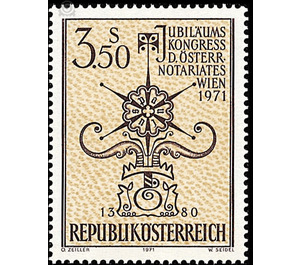congress - Austria / II. Republic of Austria 1971 - 3.50 Shilling
Theme: Calender
| Country | Austria / II. Republic of Austria |
| Issue Date | 1971 |
| Face Value | 3.50 |
| Color | brown yellow |
| Printing Type | combination printing |
| Stamp Type | Commemorative |
| Item Type | Stamp |
| Chronological Issue Number | 702 |
| Chronological Chapter | OOS-OE2 |
| SID | 424087 |
| In 69 Wishlists | |
The brand motif shows the signet of the South Tyrolean notary Paulus de Franchenfordia in the form of a stylized flower. The so-called Notarsignet can be found on notarial deeds between the 14th and 18th centuries. Once a notary had decided on a certain sign, he was allowed to change it only with the consent of the authorities. At the beginning, the signet was painstakingly drawn freehand each time, until in the 17th century the stencil and finally in the 18th century the signet was created by means of a copper engraving process. Finally, at the end of the 18th century, a single official seal was introduced, and today the notary uses his official seal. The jubilee congress of 1971 was dominated by the notarial code, because in 1871 a new notarial code was introduced under Emperor Franz Josef I, which is still the legal basis for the activities of Austrian notaries.


